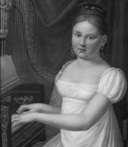Marianna Bottini
Marianna Bottini née Motroni-Andreozzi (7 November 1802 – 25 January 1858) was an Italian composer and harp teacher. She was born in Lucca, daughter of the nobleman Sebastiano Motroni-Andreozzi and his wife Eleonora Flekestein.[1][2]

Marianna Bottini
She studied counterpoint with Domenico Quilici and was admitted to the Accademia Filarmonica in Bologna in 1820 as an 'honorary master composer'. In 1823 she married the Marquis Lorenzo Bottini, a prominent political figure. She was one of the few women whose music was played for the traditional festival in honor of St. Cecilia. She died in Lucca.[3]
Works
Bottini composed most of her works between the ages of 13-20, including music for salons and sacred works. Selected compositions include:
- Elena and Gerardo, unperformed opera, 1822
- In sacred hymns for three voices, wind instruments, basso continuo, 1819
- Briseis (C. Moscheni) cantata for 3 voices, chorus, orchestra, 1820
- Cantiamo Pastori cantata for 5 voices, orchestra
- Motet for one voice, orchestra, 1818
- Qui Tollis for one voice, chorus, orchestra, 1818
- Messa da Requiem for 4 voices, orchestra, 1819
- Motet for one voice, orchestra, 1819
- Quoniam for Bass and orchestra, 1819
- Qui Tollis for Bass and orchestra, 1819
- Stabat Mater for 3 voices, 1819
- Te Deum for 3 voices, 1819
- Stabat Mater for voices 3, 1820
- Mass for Saint Cecilia for 4 voices, orchestra, 1822
- Motet for Saint Cecilia for one voice, orchestra, 1822
- Mag for 4 voices, orchestra, after 1823
- Miserere for 3 voices, basso continuo, 1824
- Crucifixus for 2 voices, continuo
- Dixit Dominus for 5 voices, orchestra
- Domino ad adjuvandum for 4 voices, orchestra[4]
- Symphonie for orchestra, 1818
- Symphonie for wind band, 1819
- Clarinet concerto
- Piano concerto "Concertone", 1822
- Quartet for harp, piano, clarinet and horn
gollark: Yes, THANK YOU, gnobody, for CORRECTING my ACCIDENTAL spelling ERROR.
gollark: Not... *that*.
gollark: If you wanted to ocnvert a number into a vector of digits, the right way would be repeated div/mod-ing.
gollark: Is that not the standard tool for reverse engineering?
gollark: However, why even.
References
- Sadie, Julie Anne; Samuel, Rhian (1994). The Norton/Grove dictionary of women composers (Digitized online by GoogleBooks). Retrieved 4 October 2010.
- Cohen, Aaron I. (1981). International encyclopedia of women composers.
- Marianna Bottini: una musicista lucchese dell'Ottocento (1802-1858). Istituto storico lucchese. 2007.
- La Pusata, Maria Sabrina. "Bottini, Marianna". Archived from the original on 14 November 2010. Retrieved 1 February 2011.
This article is issued from Wikipedia. The text is licensed under Creative Commons - Attribution - Sharealike. Additional terms may apply for the media files.